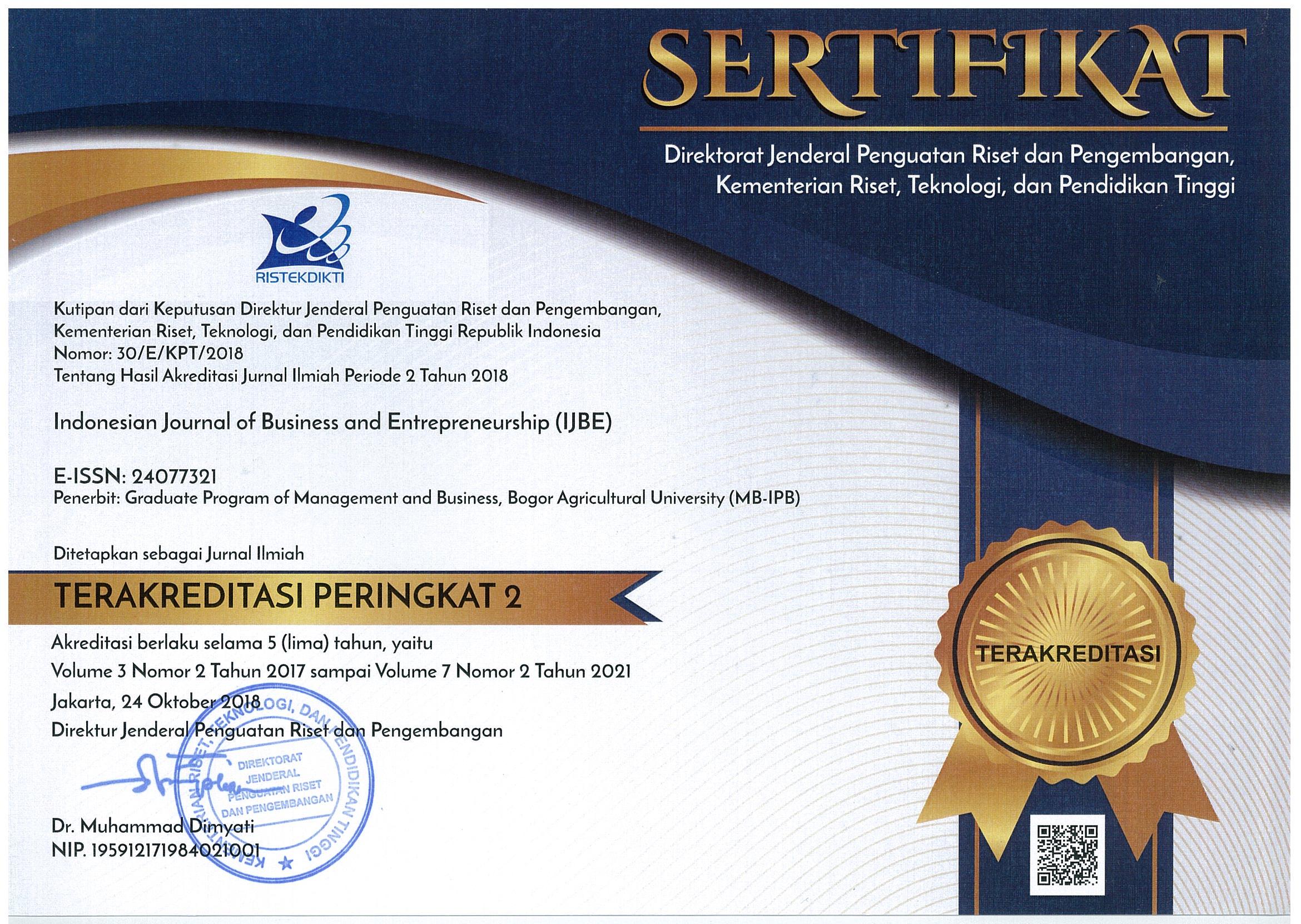The Role of Partnership in Value Chain of Sweet Potato in Regency of West Java (Case Study of PT Galih Estetika Indonesia Partnership)
Abstract
The partnership between the farmers and PT Galih Estetika Indonesia as the exporter company in the field of sweet potato processing is expected to support the development of sweet potato agribusiness in Kuningan Regency and become one of the solutions for farmers’ problems. Termination of partnership contracts undertaken by the farmers will have an impact on the implementation of partnerships, company operations as well as the value chain. This study aims to analyze the pattern of partnership, degree of partnership, value chain structure, value chain governance, farmers’ income (partner and non-partner) and margin. The method of data processing and data analysis used the descriptive analysis qualitative and quantitative descriptive analysis. The results showed that the pattern of partnership that is formed is a centralized pattern with the degree value of partnership of 716 (madya pattern). The structure of the value chain by mapping the actors and their activities result in relationships and coordination between the parties. Farmers with companies belong to the modular type in VCG. Economic benefits indicate that net income of partner farmers is Rp22,157,828/Ha, while non-partner farmers obtain Rp12,306,789/Ha and the smallest margin is obtained by the coordinator. The analysis shows that farmers' incomes are larger, but partnership planning has not been ideal. Therefore, the roles of farmers, companies and related agencies are required in the running of the ideal sweet potato partnership program.
Keywords: sweet potato partnership, partnership pattern, value chain, value chain governance, revenue
Downloads
References
[ACIAR] Australian Centre for International Agricultural Research. 2012. Membuat Rantai Nilai Lebih Berpihak Kepada Kaum Miskin. Canbera: Australian Centre for International Agricultural Research
Asmarantaka RW. 2012. Pemasaran Agribisnis (Agrimarketing). Bogor: Departemen Agribisnis FEM-IPB.
[Distankan] Dinas Pertanian, Peternakan dan Perikanan Kabupaten Kuningan. 2014. Produksi tanaman pangan Kabupaten Kuningan tahun 2012-2013. Kuningan: Dinas Pertanian, Peternakan dan Perikanan Kabupaten Kuningan.
Daryanto A. 2009. Kemitraan dalam Manajemen Rantai Nilai Bisnis Peternakan. Trobos. Rubrik Opini.
Eaton C, Shepherd AW. 2001. Contract Farming Partnership for Growth. FAO Agriculture Organization Services Buletin 145.
Gereffi G, Humphrey J, Sturgeon T. 2005. The governance of global value chain. Review of International Political Economy 12(1): 78–104. https://doi.org/10.1080/09692290500049805.
Hafsah JM. 2000. Kemitraan Usaha, Konsep dan Strategi. Jakarta: PT Penebar Swadaya.
Kodigehalli. 2004. Value chain analysis for coffe in Karnataka, India [thesis]. Jerman: University ff Berlin.
Risenasari H. 2013. Analisis peranan kemittraan terhadap rantai nilai sapi potong peternakan rakyat di Kabupaten Banjarnegara, Provinsi Jawa Tengah [tesis]. Bogor: Institut Pertanian Bogor.
Schipmann.2006. Value chains for a better integration of smallholders to trader-the case of Chili in Ghana [thesis]. Berlin: Departement of Agricultural Economics and Social
Soekartawi A, Soeharjo, Dillon JL, Hardaker JB. 2011. Ilmu Usahatani dan Penelitian untuk Pengembangan Petani Kecil. Jakarta: Universitas Indonesia Press.
Stefanus S, Supriharyono, Bambang AN. 2007. Pengelolaan sumberdaya pesisir dan laut melalui pemberdayaan kearifan lokal di Kabupaten Lembata Propinsi Nusa Tenggara Timur. Jurnal Pasir Laut 2(2): 67–82.
Trienekens J. 2011. Agriculture value chain in developing countries a framework for analysis. International Food and Agribusiness Management Review 14 (2): 51–82.
[UNDP] United Nations Development Programme. 2014. Kajian Ubi Jalar dengan Pendekatan Rantai Nilai dan Iklim Usaha di Kabupaten Jayawijaya. Papua: United Nations Development Programme.








